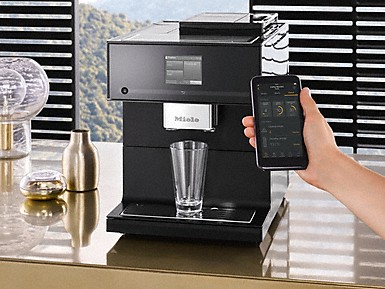High-Tech Espresso Makers For Your Home
It’s never been easier to brew your own coffee.
For some, coffee isn’t just an essential morning elixir—it’s a way of life.
For the bean-obsessed, it makes sense to invest in a machine befitting their beloved beverage, and, fortunately, technology has reached a point where coffee lovers can create cafe-quality coffee drinks—without barista training—in their own home.
Miele CM 7750 CoffeeSelect

Miele
Offering 20 drink specialities at the tap of a button, including single and double-shot espressos and espresso macchiatos, the Miele CM 7750 CoffeeSelect is a masterpiece of modern coffee-making technology that sits on your countertop.
In addition to offering on-demand espressos (and cappuccinos and americanos, etc.), the CM 7750 puts a premium on quality with three separate bean containers (ensuring that whatever you order will be prepared with the proper bean); an innovative grinder system that grinds the beans fresh for each order; and a descaling process that automatically prevents the build of limescale in your machine. All that and Miele’s WiFiConn@ct technology that allows owners to operate and monitor their machine remotely from their smartphone.
The Miele CM 7750 CoffeeSelect is available for approx. $7400.
JURA GIGA 6

JURA
This Swiss-made wonder is a tale of twos. Equipped with two heating systems, two pumps and two electronically adjustable, precision ceramic disc grinders, the JURA GIGA 6 is capable of producing two separate coffee drinks at the same time. But the real magic with the GIG6 happens when these dual systems work in conjunction—heating and frothing your milk perfectly while simultaneously brewing your coffee—for an optimally prepared cafe-quality drink, of which you’ll have many choices. The GIGA 6 can create 28 specialty drinks, using three different brewing processes. But its ample brains don’t stop there. The GIGA 6’s artificial intelligence system uses a self-learning algorithm to discover a user’s preferences and then tailors the touchscreen to highlight preferred drinks and brewing methods.
The JURA GIGA 6 is available for $6490
Breville Oracle Touch Espresso Machine

Breville
Espresso lovers who want to focus solely on their drink of choice would do well to invest in the Oracle Touch Espresso Machine from Breville. The Oracle only brews five types of specialty drinks (espresso, americano, latte, flat white and cappuccino), but it handles every step of the process. Oracle owners need only tap a button and the machine will grind, dose and tamp coffee, extract at the ideal water temperature and pressure, and texture milk to your taste, to prepare your ideal bean-based beverage. The Breville’s awesome automation doesn’t prevent users from having input, however. Oracle owners can easily adjust coffee strength, milk texture and temperature, shot size and choose from 45 different grind settings.
The Breville Oracle Touch Espresso Machine is available for $3299
Philips Saeco Xelsis

Philips
For coffee fans who want to play the part of barista—but, you know, without all the hard work—the Philips Saeco Xelsis is a solid choice. The Xelsis is capable of preparing 15 different espresso and coffee drinks, but here’s the beauty—users can exercise complete control over the process (easily) thanks to the Coffee Equalizer system. Providing total personalization, the Coffee Equalizer system is a touchscreen that allows users to adjust every aspect of the beverage until they find the mix that is ideal specifically for them. The Xelsis will even save up to six user profiles so that everyone in the home can have their drink preferences preserved. And in keeping with Xelsis’ “be the barista without the work” philosophy, the device will automatically clean and descale itself.
The Philips Saeco Xelsis is available for approx. $2642
 Copyright 2020, Dow Jones & Company, Inc. All Rights Reserved Worldwide. LEARN MORE
Copyright 2020, Dow Jones & Company, Inc. All Rights Reserved Worldwide. LEARN MORE
This stylish family home combines a classic palette and finishes with a flexible floorplan
Just 55 minutes from Sydney, make this your creative getaway located in the majestic Hawkesbury region.
More than one fifth of Australians are cutting back on the number of people they socialise with
Australian social circles are shrinking as more people look for ways to keep a lid on spending, a new survey has found.
New research from Finder found more than one fifth of respondents had dropped a friend or reduced their social circle because they were unable to afford the same levels of social activity. The survey questioned 1,041 people about how increasing concerns about affordability were affecting their social lives. The results showed 6 percent had cut ties with a friend, 16 percent were going out with fewer people and 26 percent were going to fewer events.
Expensive events such as hens’ parties and weddings were among the activities people were looking to avoid, indicating younger people were those most feeling the brunt of cost of living pressures. According to Canstar, the average cost of a wedding in NSW was between $37,108 to $41,245 and marginally lower in Victoria at $36, 358 to $37,430.
But not all age groups are curbing their social circle. While the survey found that 10 percent of Gen Z respondents had cut off a friend, only 2 percent of Baby Boomers had done similar.
Money expert at Finder, Rebecca Pike, said many had no choice but to prioritise necessities like bills over discretionary activities.
“Unfortunately, for some, social activities have become a luxury they can no longer afford,” she said.
This stylish family home combines a classic palette and finishes with a flexible floorplan
Just 55 minutes from Sydney, make this your creative getaway located in the majestic Hawkesbury region.






















